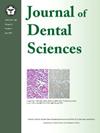全长度16S rRNA测序揭示牙周炎患者龈上菌斑微生物特征
IF 3.1
3区 医学
Q1 DENTISTRY, ORAL SURGERY & MEDICINE
引用次数: 0
摘要
背景/目的牙周炎是一种慢性炎症性疾病,可破坏口腔微生物稳态并导致全身性炎症。虽然以前的研究主要集中在龈下微生物群,但龈上菌斑作为早期微生物库的作用仍未得到充分探索。大多数先前的研究都依赖于短读16S rRNA测序,但缺乏详细的分类。本研究使用第三代测序技术(TGS)和全长度16S rRNA测序和基于dada2的误差校正来更好地表征牙周炎的龈上微生物组。材料与方法共招募30名参与者(15名牙周炎患者和15名健康对照)。收集龈上菌斑样本,使用TGS平台进行全长度16S rRNA测序。测序数据使用DADA2进行误差校正,并使用Human Oral Microbiome Database (HOMD)进行分类分类,包括多样性指数和主成分分析(PCA),比较组间微生物组成。结果牙周炎组微生物多样性显著增高(P <;0.05)和主要牙周病原体的富集,包括卟啉单胞菌、普雷沃氏菌、梭杆菌和密螺旋体。另一方面,共生细菌如链球菌和奈瑟菌在健康组中更为丰富。PCA显示出明显的聚类模式,表明龈上微生物的转移与疾病进展相关。结论本研究利用16S rRNA全长测序技术提供了牙周炎龈上菌斑的高分辨率微生物图谱。研究结果表明,龈上菌斑可能是牙周病原体的早期储存库,导致龈下定植和疾病进展。它强调了微生物生物标志物在早期诊断中的潜力,并表明可以开发基于微生物组的靶向治疗来恢复牙周病中的微生物平衡。这种方法提供了更精确的细菌鉴定和个性化牙周护理的未来转化潜力。本文章由计算机程序翻译,如有差异,请以英文原文为准。
Full-length 16S rRNA sequencing reveals microbial characteristics in supragingival plaque of periodontitis patients
Background/Purpose
Periodontitis is a chronic inflammatory disease that disrupts oral microbial homeostasis and contributes to systemic inflammation. While previous studies have focused on subgingival microbiota, the role of supragingival plaque as an early microbial reservoir remains underexplored. Most previous studies have relied on short-read 16S rRNA sequencing but limited detailed classification. This study uses Third-Generation Sequencing (TGS) with full-length 16S rRNA sequencing and DADA2-based error correction to better characterize the supragingival microbiome in periodontitis.
Materials and methods
A total of 30 participants (15 periodontitis patients and 15 healthy controls) were recruited. Supragingival plaque samples were collected, and full-length 16S rRNA sequencing was performed using a TGS platform. Sequencing data were processed with DADA2 for error correction and taxonomic classification using the Human Oral Microbiome Database (HOMD), including diversity indices and Principal Component Analysis (PCA), which were conducted to compare microbial compositions between groups.
Results
The periodontitis group exhibited significantly higher microbial diversity (P < 0.05) and enrichment of key periodontal pathogens, including Porphyromonas, Prevotella, Fusobacterium, and Treponema. On the other hand, commensal bacteria such as Streptococcus and Neisseria were more abundant in the healthy group. PCA demonstrated distinct clustering patterns, indicating supragingival microbial shifts associated with disease progression.
Conclusion
This study provides the high-resolution microbial profiling of supragingival plaque in periodontitis using full-length 16S rRNA sequencing. The findings suggest that supragingival plaque may serve as an early-stage reservoir for periodontal pathogens, which leads to subgingival colonization and disease progression. It highlights the potential of microbial biomarkers in early diagnosis and suggests that targeted microbiome-based therapies could be developed to restore microbial balance in periodontal disease. This method offers greater precision in bacterial identification and future translational potential for personalized periodontal care.
求助全文
通过发布文献求助,成功后即可免费获取论文全文。
去求助
来源期刊

Journal of Dental Sciences
医学-牙科与口腔外科
CiteScore
5.10
自引率
14.30%
发文量
348
审稿时长
6 days
期刊介绍:
he Journal of Dental Sciences (JDS), published quarterly, is the official and open access publication of the Association for Dental Sciences of the Republic of China (ADS-ROC). The precedent journal of the JDS is the Chinese Dental Journal (CDJ) which had already been covered by MEDLINE in 1988. As the CDJ continued to prove its importance in the region, the ADS-ROC decided to move to the international community by publishing an English journal. Hence, the birth of the JDS in 2006. The JDS is indexed in the SCI Expanded since 2008. It is also indexed in Scopus, and EMCare, ScienceDirect, SIIC Data Bases.
The topics covered by the JDS include all fields of basic and clinical dentistry. Some manuscripts focusing on the study of certain endemic diseases such as dental caries and periodontal diseases in particular regions of any country as well as oral pre-cancers, oral cancers, and oral submucous fibrosis related to betel nut chewing habit are also considered for publication. Besides, the JDS also publishes articles about the efficacy of a new treatment modality on oral verrucous hyperplasia or early oral squamous cell carcinoma.
 求助内容:
求助内容: 应助结果提醒方式:
应助结果提醒方式:


